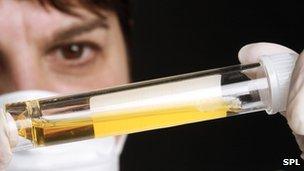Urine odour test for bladder cancer
- Published

Urine gives off a unique odour when cancer cells are present
UK scientists have made a device that can "smell" bladder cancer in urine samples.
It uses a sensor to detect gaseous chemicals that are given off if cancer cells are present.
Early trials show the tests gives accurate results more than nine times in 10, its inventors told PLoS One journal.
But experts say more studies are needed to perfect the test before it can become widely available.
Each year around 10,000 people in the UK are diagnosed with bladder cancer.
Doctors have been searching for ways to spot this cancer at an earlier stage when it is more treatable.
And many have been interested in odours in urine, since past work suggests dogs can be trained to recognise the scent of cancer.
Prof Chris Probert, from Liverpool University, and Prof Norman Ratcliffe, of the University of the West of England, say their new device can read cancer smells.
"It reads the gases that chemicals in the urine can give off when the sample is heated," said Prof Ratcliffe.
To test their device, they used 98 samples of urine - 24 from men known to have bladder cancer and 74 from men with bladder-related problems but no cancer.
Prof Probert said the results were very encouraging but added: "We now need to look at larger samples of patients to test the device further before it can be used in hospitals."
Dr Sarah Hazell, senior science communication officer at Cancer Research UK, said: "It would be great to be able to detect the 'smell' of cancer in a robust and practical way but, promising though this work is, we're not there yet.
"This latest method is still at an early stage of development, and needs to be tried out on a much larger set of samples, including samples from both women and men.
"The researchers say that the test would be around 96% accurate in practice and their findings are only based on a relatively small number of samples, taken only from men. But it is another promising step towards detecting bladder cancer from urine samples, something that would ultimately provide a less invasive means of diagnosing the disease."
- Published9 June 2013
- Published14 March 2013